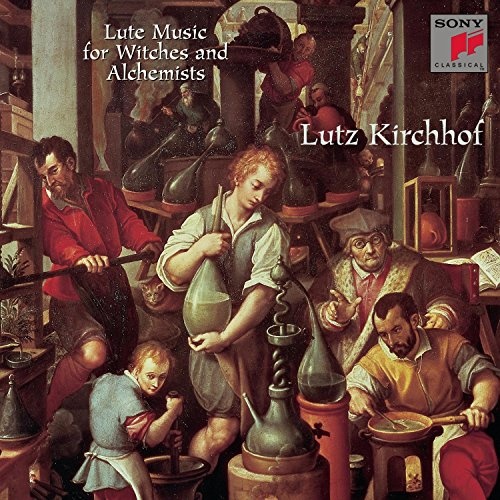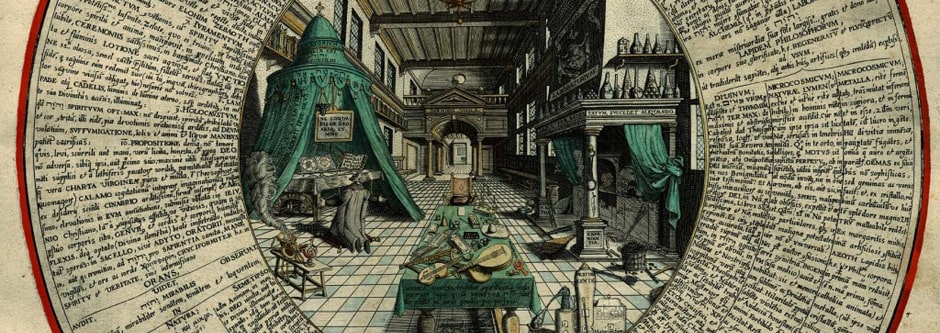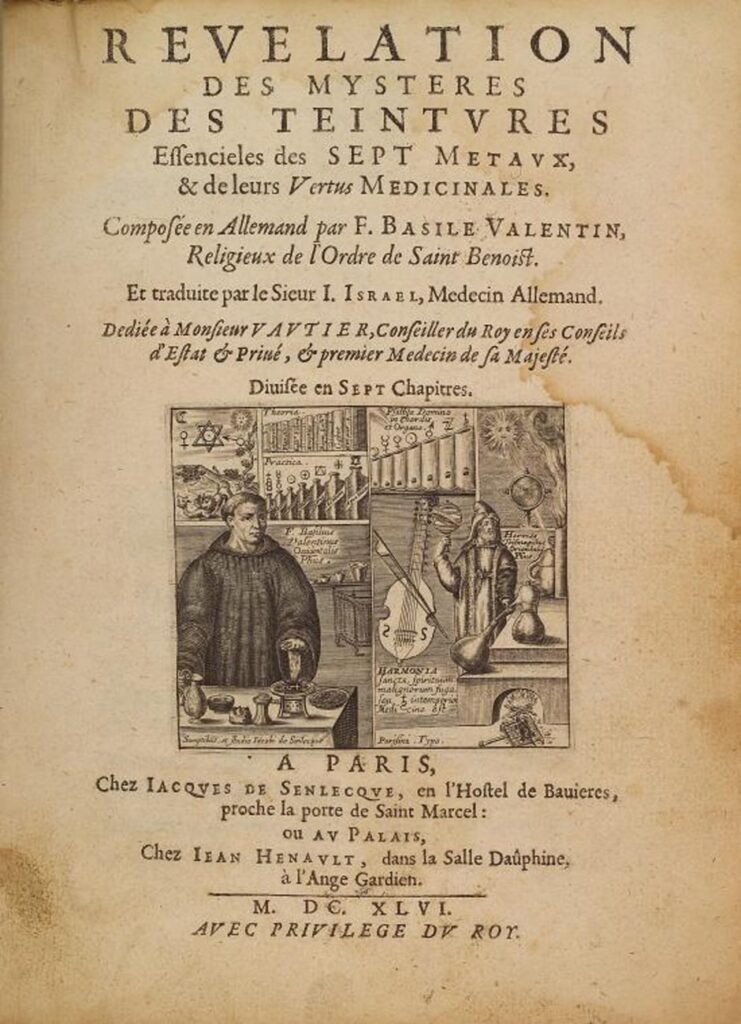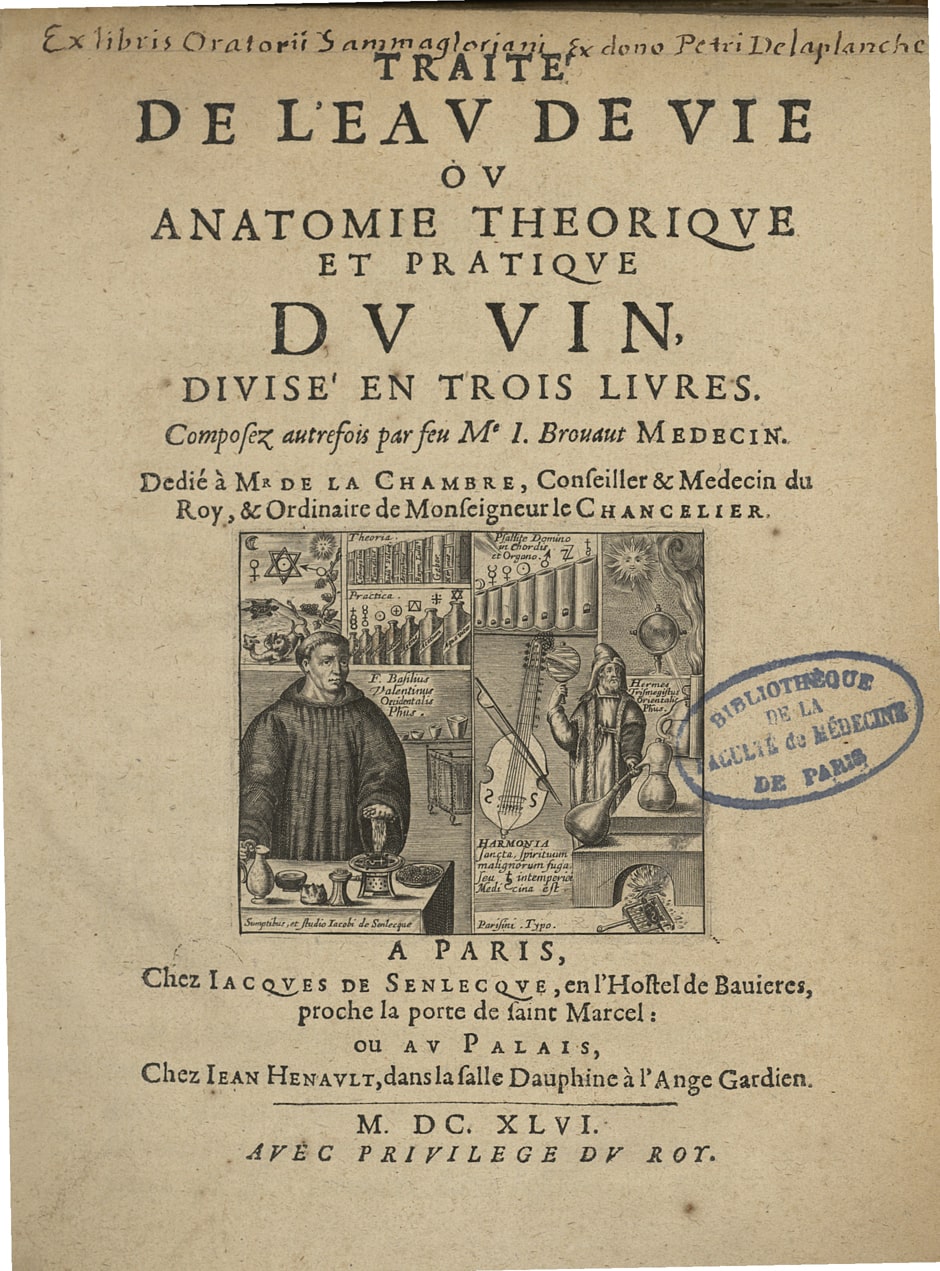ALCHEMY PUBLICATIONS AND MUSIC
The interest in music among great minds in ancient times is well know. Pythagoras argued there was a mathematical and geometrical harmony in the cosmos (Musica Universalis or ‘Music of the Spheres’ – I briefly wrote about it in this article on Roel’s World). The four arts Astronomy, Arithmetic, Geometry and Music were known from the time of Boethius onwards as the Quadrivium“. Eventually after the 9th century Rhetoric, Grammar and Dialectic (Logica), grouped as the Trivium, where added. Together they came to be known as the Seven Liberal Arts (Artes Liberales, Septem Artes Liberales, Studia Liberalia).
This article is not about and the Seven Liberal Arts though, but about the musical references in alchemy. I became inspired to write about it after I was introduced to a beautiful illustration called “The First Stage of the Great Work“, better-known as the “Alchemist’s Laboratory” from the book “Amphitheatrum Sapientiae Aeternae”, written by Heinrich Khunrath (a German physician, hermetic philosopher and alchemist), first published in Hamburg (1595).
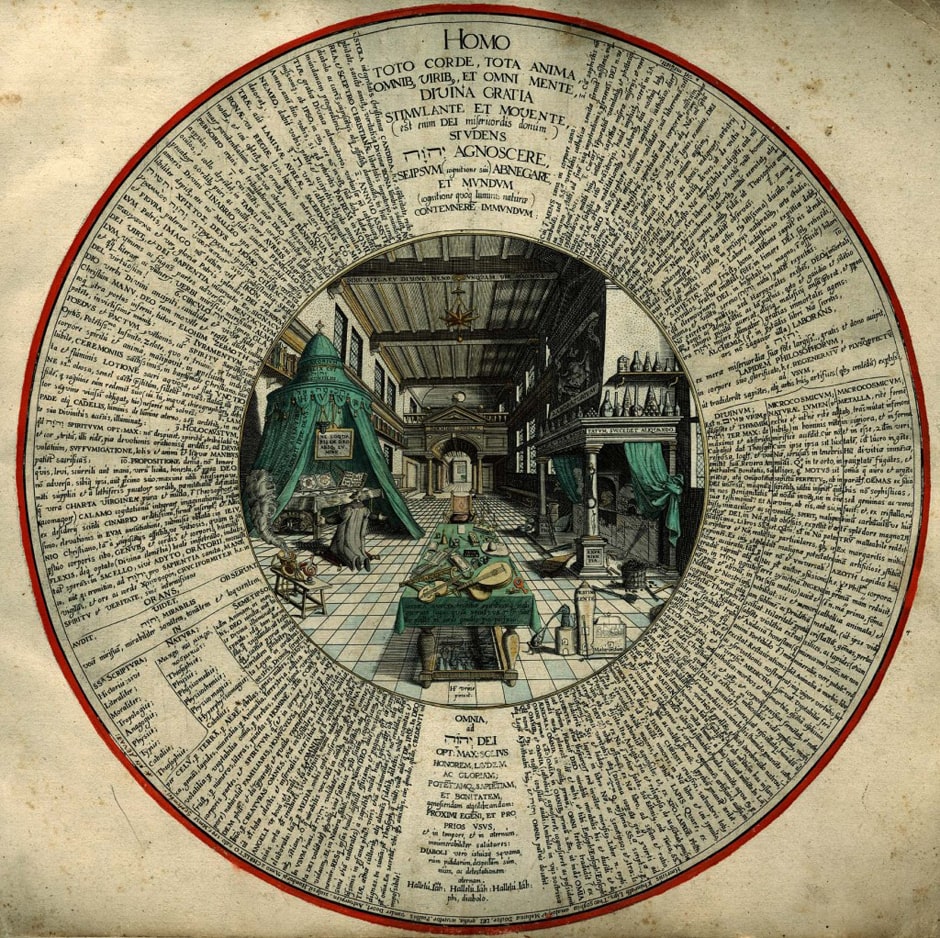
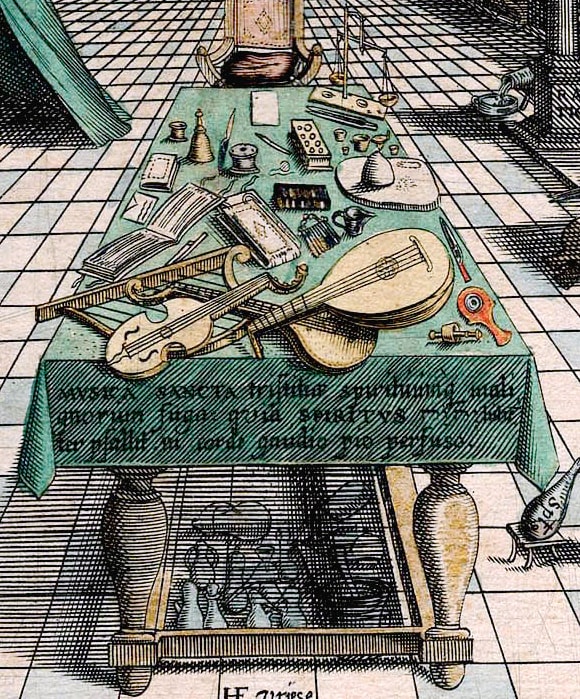
In the center of the illustration of this Alchemy Laboratory we find a table with 3 types of musical instruments: a 4-string violin, an 8 String Lyre and two 5-string lutes.
On the table cloth is written:
“MUSICA SANCTA tristitia spirituumg malignorum fuga: quiaa SPIRITUS יהוה libenter psallit in corde gaudio pio perfuso.”
→ Holy music is the sadness and flight of the evil spirits: because the spirit of YHWH willingly sings in a heart filled with pious joy.
From the middle ages on, musical instruments were not just important for the music they produced, but for what they symbolized as well, the Lyre or Harp as the foremost symbolic instrument. The lyre harp could be seen as the ladder leading to the next world (symbol for life and death, afterlife). The harp was also an emblem of King David, the Old Testament monarch and reputed writer of the Psalms. Dagda, the Celtic God of Fire, brought about the change of the seasons and made them appear in the correct order by playing a magic harp (uaithne). And, last but not least, the harp was a representation of cosmic consonance, bringing harmony between heaven and earth.
The violin symbolizes many things to different people, but at its core, it represents the ability to communicate and express oneself through the power of music. The violin and other string instruments represent cold, sadness, tranquility, sympathy, fragility, joy and is a symbol of hope, resilience, and elegance, a wide spectrum of emotions. In a Vanitas still life painting, a violin can remind viewers of the threads of time and the fact that all beautiful things must come to an end.
The Lute could be used as symbol of lust or lasciviousness; in the hands of an older man it symbolized scandal and degeneracy. Ancient Mesopotamian seals show maidens playing long-necked lutes in the cult of Inanna (Ishtar), goddess of love and destruction. The lute, with its ensemble of different pairs of strings, provided a perfect symbol for concord and harmony. Almost all depictions of the “celestial music” show angels playing the lute. The fleeting nature of its sound, and the physical fragility of the lute made it a fitting emblem of transience and death, it (like another string instruments) is often included in still life Vanitas paintings, illustrating the vanity of worldly existence.
Follow on Pinterest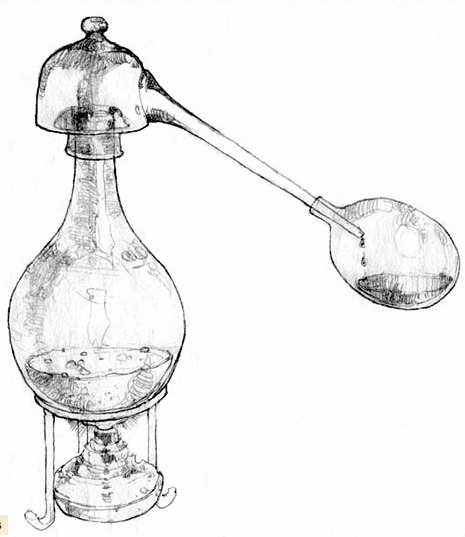
Alchemists relied on three primary components to do their work with: cucurbits (round containers made to hold the substance being distilled from one thing into another), alembics (a rounded glass head with a beak that fitted on top of the cucurbit), and phials (a small cylindrical glass bottle) that were then assembled into one device, the cucurbits and alembics sealed with lute. Obviously not the musical instrument lute, but a sticky substance.
If you look at the large image of the laboratory, you see this setup on the right, next to the table with musical instruments.
Composers also work with 3 primary components: melody, harmony and rhythm. You could look at the process of composing music as alchemic process ← read more about it on Roel’s World.
There are old alchemistic illustrations that depict instruments and with it the importance of music. To mention a couple:
- The title page from Basilica chymica, Oswald Croll, Frankfurt: Bey Gottfried Tampachen (1629)
- Frontispiece of Johann Becher’s Physica Subterranea (1738 edition)
In the ages those (and other alchemistic works) were made, some alchemists also composed alchemistic songs. To mention a few:
- “Atalanta Fugiens” by Michael Maier
- “A Philosophicall short songe of the incorporating of the Spirit of the Lord in Salt” by Heinrich Khunrath
- “The Antiphona” or “Enn pulcherlapiss” by Johannes de Teschen (or Johannes Tecenensis)
- “Processus sub forma missae”, an alchemical mass written by Melchior Cibinensis
- “Gesang von der Materia Prima” or “Song on Primal Matter” by Benedict Figulus (1603)
If you like to read more about those songs, you might enjoy reading this article by Dirk Gillabel, there are several nice historic illustrations in his article as well. The Dutch readers of this article might also find the book “Klinkende Alchemie” by Maarten Brandt a very interesting read. Since others have written about alchemistic songs already and I am not intending to reinvent the wheel …
I’d like to proceed with the alchemistic book “Révelation des mystères des teintures essentielles des sept métaux” (1646) by a F. Basil Valentine. On the title page there is an interesting illustration that caught my eye …
The illustration contains two panels that are the two sides of the alchemical work.
On the left we have the author in his laboratory – F. Basilius Valentinus Occidentalis Phil. (Frater Basilius Valentinus the Western philosopher) – representing the practical side of alchemy.
On the right side we see Hermes Trismegistus, the founder of alchemy and hermetic wisdom, representing the spiritual side of alchemy.
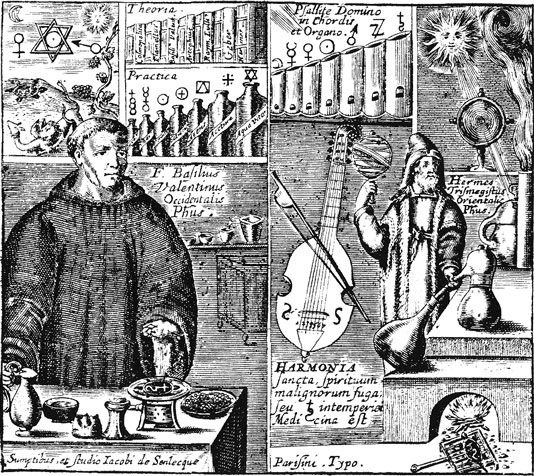
Displayed in the right-side panel on the left of Hermes is a viola da gamba. The viola da gamba, a member of the violin family has symbolically the same function as the violin described earlier in this article. The viola da gamba has 7 strings and 7 frets (thin metal bars), perhaps a reference to the 7 tones and 7 metals or classic planets.
Underneath is written:
“HARMONIA Sancta, Spiritum malignorum fuga; seu ♄ intemperivi Medicina est.“
→ Holy HARMONY, Spirit the flight of the malignant; or Saturn is the remedy for the untempered.
It’s a curious text, presuming the translation above is correct. In music the combination of simultaneously sounding musical tones is called “harmony”. The untempered, ‘just’ (consonant) intervals are considered the most harmonious.
FYI: In music theory, a temperament is a tuning system that slightly compromises the pure intervals of just intonation to meet other requirements. When an interval is untempered it means that we talk about a ‘just’ or ‘pure’ interval. Pure intervals are tone intervals as found in the harmonic series (also known as the overtone series); the sequence of harmonics, or pure tones whose frequency is an integer multiple of a fundamental frequency.
In astrology, Saturn is associated with restriction and limitation. Lead/Saturn to the alchemist of old had qualities of putrefaction, decay, limitation, protection, and self control. You could say that tempering a ‘tone’ is limiting it from resonating at its most consonant (natural) harmonic frequency.
“The ancient initiates of the priesthood believed that the solar system was organized by forces emanating from the great rings of Saturn. It was also believed that all things in the universe were under the control of Saturn. The first forms of worship by the priesthoods of the mysteries was to the planet Saturn and its gods. In those ancient days long past, Saturn was seen as the spiritual rock on which the enduring light of the solar temple stood.”
from thewonderingalchemist.com:
“Saturn is the ‘remedy’ for the untempered” (the other 6 planets/tones displayed at the illustration) might be the reference to that ancient believes that Saturn ruled over the other 6 planets.
LET’S ZOOM-IN ON THE PIPE ORGAN IN THE ILLUSTRATION:
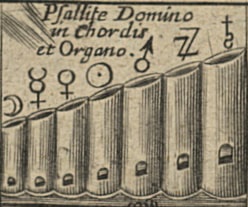
We see seven pipes of an organ, each pipe associated with one of the seven planets:
|☽ Moon | ☿ Mercury | ♀ Venus | ☉ Sun | ♂ Mars
| ♃ Jupiter | ♄ Saturn |
Above the organ pipes is the text “Psallite Domino in Chordis et Organo” (Sing ye to the Lord upon with strings and organs).
About the mentioned strings (the viola da gamba) I have shared some thoughts already, so lets focus our attention now on the pipe organ, the part of the illustration directly triggered my interest most.
Symbolically a pipe organ represents power, fury, rage, and overwhelming joy (as in various Bach compositions). By tradition these pipes were also the symbol for the “Voice of God”.
When studying this part of the illustration I wondered why that specific following order of pipe-planet combination was chosen.
With alchemy the 7 classic planets also represent 7 metals. Lead being the lowest in purity, gold the highest. If we follow the order of metals from the lowest purity to the highest we get: Lead (Saturn), Tin (Jupiter), Iron (Mars), Copper (Venus), Quicksilver (Mercury), Silver (Moon) and Gold (Sun). Alchemists hoped to achieve a transmutation of Lead into Gold.
Astronomically the order could have been based on distance from Earth, in miles that would be approx: Moon (239 mile), Venus (25.8M miles), Mars (48.6M miles), Mercury (57M miles), Sun (93M miles), Jupiter (390.6M miles), Saturn (777M miles).
Neither option matches the illustration, no matter if you would follow the order visually from low to high (smallest pipe to largest pipe) or sonically from the lowest tone to the highest (largest pipe = low tone to the smallest pipe = high tone). So, if the alchemic purification process and the astronomical distance of the planets from earth are not the reason for the order of planets in the illustration, what might it then be?
Could it be the masculine (m) and feminine (f) polarity, not based on gender, but energy? Depending on the source: Moon (f), Mercury (f), Venus (f), Sun (m), Mars (m), Jupiter (m) and Saturn (m). In some sources Jupiter is considered feminine, but in others masculine. If Jupiter is masculine, then the first 3, smaller pipes are feminine and the following 4 are masculine.
Why 3 and 4?
I am uncertain. Perhaps a reference to the Tria Prima (Tria = 3, Prima = primes) and the 4 elements? There is nothing in the illustration that would suggest that though. And the words Tria Prima do not appear in the content of the book either.
FYI: The Tria Prima are Sulphur, Mercury and Salt. Sulphur is the masculine principle, Mercury the feminine. In alchemy Sulphur also represents the element Fire, Mercury the element Air and Salt the elements Earth and Water.
Even though very interesting, there is nothing that suggests this all to be the reason for the order op pipes and planets as visualized in the illustration.
Could there be another, more likely reason?
The particular order of the planets associated with musical tones appears one to two centuries before the publication of “Révelation des mystères des teintures essentielles des sept métaux“ in Boethius‘ “De Institutione de musica” (1491-1492), and is attributed to an anonymous of the Twelfth Century.
“There is a concord of planets similar to that of notes.
source: Godwin, Joscelyn in his “Harmony of the spheres: a sourcebook of the Pythagorean tradition in music” (1993) page 123-125.
From Earth to Heaven a divine order ascends.
Tully thus enumerates them, rising from the bottom:
Moon, Hermes, Venus and Sun, Mars, Jupiter and Saturn.
In similar order you should sing your notes:
Give the Moon’s first, which is proximate to Earth,
Then observe how much higher Mercury is;
This interval in the musical system amounts to one tone.
Venus, following, certainly marks off an interval worth a leimma*;
Then a tone to the Sun fills out the fourth.
And bellicose Mars with another tone completes a fifth.
Jupiter of the white locks sings his brief leimma*,
And lofty Saturn, for his part, joins a tone to these…”
* Leimma (Limma) refers to several different musical intervals, whose only common property is their size, smaller than a Tone. The Limma is a tone interval typical for 3-limit (Pythagorean) and 5-limit tuning systems. In the period these alchemy books were published, the common tuning method was Pythagorean tuning, later followed by the Meantone temperament.
FYI: 12-Tone music scales are build with Tones (T) and Semitones (S) also called half-tones. Before the Renaissance, Pythagorean tuning (Quartal harmony) was used. Pythagorean tuning is a system of just intonation, based on the stacking of pure perfect fifths . In the Renaissance and Baroque periods musicians wished to make much more use of Tertian harmony and therefor started to ‘temper’ the Pythagorean tuning system. The Quarter-comma meantone temperament and later the 12-Tone Equal Temperament (12-TET or 12-ET) was the result. 12-TET is the commonly used temperament in the West nowadays, a temperament where every semitone (S) equals 1/12th of the octave (12 tones equally spaced on a logarithmic scale), thus every Tone (T) equals 2/12th of the octave. 12-TET was first calculated in 1584 by Chu-Tsaiyu and 1585 by Simon Stevin. The alchemic publications mentioned in this article thus all predate 12-Tone Equal Temperament.
So, let’s have a look again what the text tells us. I will use colors to accentuate the important bits ‘n pieces:
“Give the Moon’s first, which is proximate to Earth,
Then observe how much higher Mercury is;
This interval in the musical system amounts to one tone.
Venus, following, certainly marks off an interval worth a leimma;
Then a tone to the Sun fills out the fourth.
And bellicose Mars with another tone completes a fifth.
Jupiter of the white locks sings his brief leimma,
And lofty Saturn, for his part, joins a tone to these…”
If we follow the instructions correctly then the following planet – tonal combination takes shape degree by degree forming a diatonic scale:
| Moon | 1st degree | |
| T | ||
| Mercury | 2nd degree | |
| S | ||
| Venus | 3rd degree | |
| T | ||
| Sun | 4th degree | |
| T | ||
| Mars | 5th degree | |
| S | ||
| Jupiter | 6th degree | |
| T | ||
| Saturn | 7th degree |
The scale formed above is known as the Aeolian (natural minor) scale.
LET’S ADD SOME DO-RE-ME TO THE THEORY …
Theorizing and philosophizing is fun, but being able to implement a theory, in this case to ‘sonify’ – or ‘solmizate’ – the illustration, is even more fun.
FYI: The Solfeggio (Solfège) system – a form of solmization (a system of attributing a distinct syllable to each note of a musical scale → Do – Re – Mi – Fa – Sol – La – Si/Ti) – was created in eleventh-century Italy by the Benedictine monk, music theorist and pedagogue of High medieval music Guido of Arezzo. Each syllable relates to one of 7 degrees in the diatonic scale. There are two types of Solfeggio systems: the “fixed-do” system (common in Romance and Slavic countries) and the “movable-do” system (common in Germanic countries, Commonwealth countries, and the United States).
Basil Valentine, the proclaimed author of “Révelation des mystères des teintures essentielles des sept métaux” (1646) was ostensibly a German alchemist but more likely a pseudonym used by one or several 16th-century German authors. If Valentine had created/provided the frontpage, then the movable-do system would most likely have been the Solfège system related to the scale of planets/metals & tones.
With the movable-do system the Do is synonymous with the 1st degree (Unison, or Prime) of any scale in any and all tonalities. What exact pitch / frequency the tone Do represents therefore depends on the tonality. That could be any one of the tones of the tuning system used, in Western Music thus any one of 12 tones, therefor Do could be the Unison of 12 Major and 12 Minor scales (in the west). What we can be sure of, is that the clues in the text suggest it had to be a Aeolian (natural minor) scale. Thus, one of 12 minor scales are optional and that is where the trail ends. This means that we can’t relate a specific tone pitch / frequency to the planets as such … and it thus becomes impossible to define the exact tone frequencies represented by each organ pipe in the illustration.
| Moon | 1st degree | Do | |
| T | |||
| Mercury | 2nd degree | Re | |
| S | |||
| Venus | 3rd degree | Me* | |
| T | |||
| Sun | 4th degree | Fa | |
| T | |||
| Mars | 5th degree | Sol | |
| S | |||
| Jupiter | 6th degree | Le* | |
| T | |||
| Saturn | 7th degree | Te* |
* Me (or Ma) is used instead of Mi due to the Limma, the interval Re-Me being approx.a semitone smaller then Re-Mi.
* Le (or Lo) is used instead of La due to the Limma, the interval Sol-Le being approx.a semitone smaller then Sol-La.
* Te (or Ta) is used instead of Ti, the interval Le-Te is a tone, Te is approx.a semitone lower then Ti.
Now, let’s forget about science and facts for just a second … and add some “what ifs” to the story.
The book was published in France. What we know is that the exact same illustration used for “Révelation des mystères des teintures essentielles des sept métaux” (1646) by Basil Valentine, was used as well for the in the same year published book “Traité de l’eau de vie ou anatomie théorique et pratique du vin” (1646) by Jean Brouaut. This suggests that the frontpage was added by the French publisher.
For those among you that master the French language, here are copies of the original books:
– Révelation des mystères des teintures essentielles des sept métaux [ PDF ]
– Traité de l’eau de vie ou anatomie théorique et pratique du vin [ PDF ]
Here it comes … What IF … the fixed-do system was the intended Solfège system, native to France, the country housing the publisher and perhaps illustrator?
With the fixed-do system the first degree is Do that is synonymous with the tone C.
| Moon | 1st degree | Tonic | Do = | C | |
| T | |||||
| Mercury | 2nd degree | Supertonic | Re = | D | |
| S | |||||
| Venus | 3rd degree | Mediant | Me = | E♭ | |
| T | |||||
| Sun | 4th degree | Subdominant | Fa = | F | |
| T | |||||
| Mars | 5th degree | Dominant | Sol = | G | |
| S | |||||
| Jupiter | 6th degree | Submediant | Le = | A♭ | |
| T | |||||
| Saturn | 7th degree | Leading Tone | Te = | B♭ |
Well, well, well … there you go? The C Aeolian (C natural minor) scale.
And this is how it sounds:
Of course the instrument used for this fragment is piano instead of pipe organ, but you get the picture, right?
SOURCES:
– Wikipedia
– A. Bos (suggestion about the planetary genders).
– https://www.thewonderingalchemist.com/blog/
– soul-guidance.com
– Juliane Müller
I’d like the end this article on a happy note, with Lute Music for Witches and Alchemists by Lutz Kirchhof
